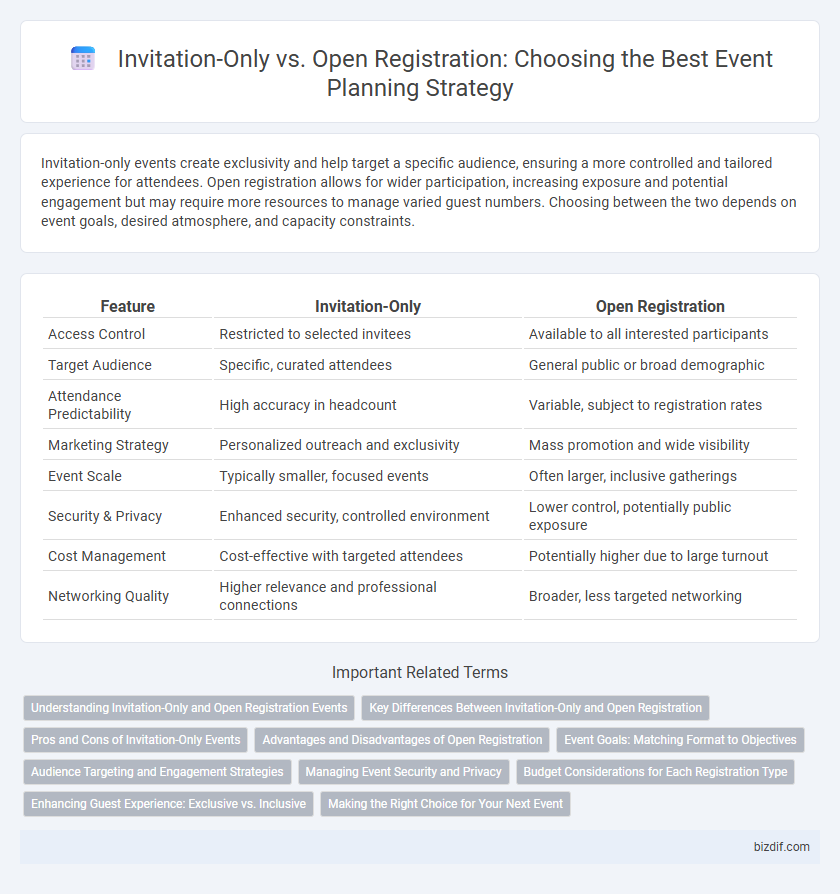Invitation-only events create exclusivity and help target a specific audience, ensuring a more controlled and tailored experience for attendees. Open registration allows for wider participation, increasing exposure and potential engagement but may require more resources to manage varied guest numbers. Choosing between the two depends on event goals, desired atmosphere, and capacity constraints.
Table of Comparison
| Feature | Invitation-Only | Open Registration |
|---|---|---|
| Access Control | Restricted to selected invitees | Available to all interested participants |
| Target Audience | Specific, curated attendees | General public or broad demographic |
| Attendance Predictability | High accuracy in headcount | Variable, subject to registration rates |
| Marketing Strategy | Personalized outreach and exclusivity | Mass promotion and wide visibility |
| Event Scale | Typically smaller, focused events | Often larger, inclusive gatherings |
| Security & Privacy | Enhanced security, controlled environment | Lower control, potentially public exposure |
| Cost Management | Cost-effective with targeted attendees | Potentially higher due to large turnout |
| Networking Quality | Higher relevance and professional connections | Broader, less targeted networking |
Understanding Invitation-Only and Open Registration Events
Invitation-only events restrict attendance to selected individuals, ensuring a curated guest list that enhances exclusivity and targeted networking opportunities. Open registration events allow any interested participants to join, maximizing reach and inclusivity, which can drive higher attendance and brand exposure. Choosing between invitation-only and open registration depends on event goals, audience engagement strategies, and desired attendee experience.
Key Differences Between Invitation-Only and Open Registration
Invitation-only events restrict attendance to selected guests who receive personalized invites, ensuring a curated audience that aligns with specific event goals such as networking or exclusivity. Open registration allows any interested participant to sign up, maximizing reach and encouraging diverse attendance but potentially diluting targeted engagement. Key differences include control over guest list quality, attendee diversity, event scale, and logistical planning complexity.
Pros and Cons of Invitation-Only Events
Invitation-only events offer the advantage of curating a targeted guest list, ensuring attendees align with the event's purpose and enhancing networking opportunities. However, this exclusivity can limit diversity and reduce overall attendance, potentially impacting event reach and revenue. Managing invitations requires meticulous coordination and follow-up, which can increase planning complexity and costs.
Advantages and Disadvantages of Open Registration
Open registration increases event accessibility and attracts a larger, diverse audience, boosting overall attendance and networking opportunities. However, it may lead to overcrowding, reduced engagement, and less control over participant quality compared to invitation-only events. Event planners must balance the benefits of broader reach with potential challenges in managing event logistics and maintaining exclusivity.
Event Goals: Matching Format to Objectives
Invitation-only events create an exclusive atmosphere that fosters high-level networking and targeted engagement, ideal for corporate launches or strategic workshops. Open registration maximizes reach and inclusivity, making it suitable for public conferences or community events aiming for broad participation. Aligning the registration format with event goals ensures optimal attendee quality and enhances overall event impact.
Audience Targeting and Engagement Strategies
Invitation-only events enable precise audience targeting by selecting guests based on specific criteria, enhancing personalized engagement and fostering a sense of exclusivity. Open registration broadens reach, allowing diverse attendee demographics while demanding robust engagement strategies like interactive content and real-time communication to maintain interest. Tailoring communication methods to each registration type maximizes attendee participation and satisfaction.
Managing Event Security and Privacy
Invitation-only events enhance security by limiting access to pre-approved guests, reducing the risk of unauthorized entry and protecting sensitive information. Open registration increases exposure to a broader audience but requires robust identity verification and monitoring systems to manage privacy effectively. Employing secure digital platforms with encryption and real-time tracking can help maintain control over attendee information regardless of registration type.
Budget Considerations for Each Registration Type
Invitation-only events often reduce costs by limiting the number of attendees, enabling more precise budgeting for venue size, catering, and materials. Open registration events require flexible budget allocations to accommodate unpredictable attendance, often leading to higher contingency expenses for larger venues and additional resources. Careful analysis of target audience size and event goals helps optimize budget efficiency for either registration type.
Enhancing Guest Experience: Exclusive vs. Inclusive
Invitation-only events create a sense of exclusivity and personalized attention, enhancing guest experience by making attendees feel specially chosen and valued. Open registration encourages inclusivity and diversity, allowing broader participation and fostering community engagement. Balancing exclusivity with accessibility depends on event goals and target audience preferences.
Making the Right Choice for Your Next Event
Choosing between invitation-only and open registration depends on your event's goals and target audience. Invitation-only events foster exclusivity and control, ensuring a curated guest list aligned with brand or business objectives. Open registration maximizes attendance and inclusivity, ideal for public outreach, community engagement, or large-scale networking opportunities.
Invitation-only vs open registration Infographic

 bizdif.com
bizdif.com